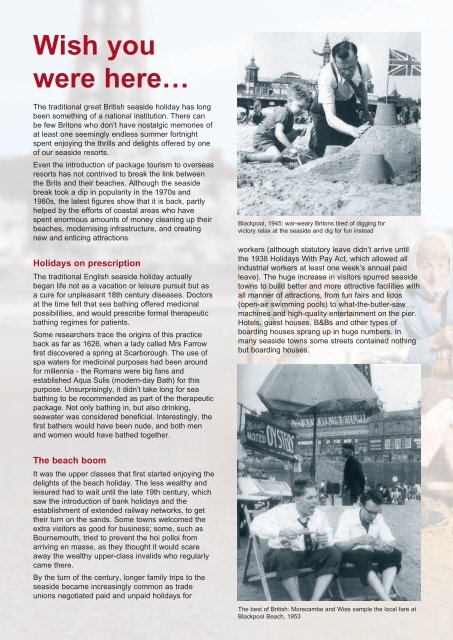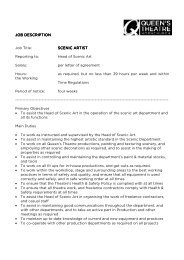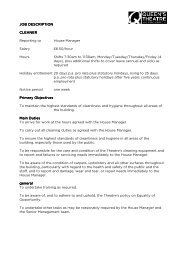Wish youwere here…<strong>The</strong> traditional great British seaside holiday has longbeen something of a national institution. <strong>The</strong>re canbe few Britons who don’t have nostalgic memories ofat least one seemingly endless summer fortnightspent enjoying the thrills and delights offered by oneof our seaside resorts.Even the introduction of package tourism to overseasresorts has not contrived to break the link betweenthe Brits and their beaches. Although the seasidebreak took a dip in popularity in the 1970s and1980s, the latest figures show that it is back, partlyhelped by the efforts of coastal areas who havespent enormous amounts of money cleaning up theirbeaches, modernising infrastructure, and creatingnew and enticing attractions.Holidays on prescription<strong>The</strong> traditional English seaside holiday actuallybegan life not as a vacation or leisure pursuit but asa cure for unpleasant 18th century diseases. Doctorsat the time felt that sea bathing offered medicinalpossibilities, and would prescribe formal therapeuticbathing regimes for patients.Some researchers trace the origins of this practiceback as far as 1626, when a lady called Mrs Farrowfirst discovered a spring at Scarborough. <strong>The</strong> use ofspa waters for medicinal purposes had been aroundfor millennia - the Romans were big fans andestablished Aqua Sulis (modern-day Bath) for thispurpose. Unsurprisingly, it didn’t take long for seabathing to be recommended as part of the therapeuticpackage. Not only bathing in, but also drinking,seawater was considered beneficial. Interestingly, thefirst bathers would have been nude, and both menand women would have bathed together.Blackpool, 1945: war-weary Britons tired of digging forvictory relax at the seaside and dig for fun insteadworkers (although statutory leave didn’t arrive untilthe 1938 Holidays With Pay Act, which allowed allindustrial workers at least one week’s annual paidleave). <strong>The</strong> huge increase in visitors spurred seasidetowns to build better and more attractive facilities withall manner of attractions, from fun fairs and lidos(open-air swimming pools) to what-the-butler-sawmachines and high-quality entertainment on the pier.Hotels, guest houses, B&Bs and other types ofboarding houses sprang up in huge numbers. Inmany seaside towns some streets contained nothingbut boarding houses.<strong>The</strong> beach boomIt was the upper classes that first started enjoying thedelights of the beach holiday. <strong>The</strong> less wealthy andleisured had to wait until the late 19th century, whichsaw the introduction of bank holidays and theestablishment of extended railway networks, to gettheir turn on the sands. Some towns welcomed theextra visitors as good for business; some, such asBournemouth, tried to prevent the hoi polloi fromarriving en masse, as they thought it would scareaway the wealthy upper-class invalids who regularlycame there.By the turn of the century, longer family trips to theseaside became increasingly common as tradeunions negotiated paid and unpaid holidays for<strong>The</strong> best of British: Morecambe and Wise sample the local fare atBlackpool Beach, 1953
Living by the seaAdvances in computer-based communication, flexibleworking arrangements and more business contactwith Europe have made living on the coast and eithercommuting to work in the city or travelling to townonly when necessary far more feasible. All of whichhas introduced a degree of metropolitan sophisticationto some previously traditional seaside towns; Brightonis probably the best example of this phenomenon.<strong>The</strong> seaside experience<strong>The</strong>re is nothing quite like a British seaside holiday.While the tanned, rippling bodies on Bondi or MiamiBeach luxuriate in glorious sunshine showing off theirperfectly toned anatomies, sipping piña coladas andfrolicking about on expensive yachts in busy marinas,we build sandcastles, watch one wooden puppetbashing the living daylights out of another, andcontrive to lose all our spare change into slot andarcade machines.While the denizens of the Bahamas and the Balearicssaunter across idyllic sun-drenched sands, picking uppure, bleached conch shells and resting beneathshady palms, we shiver behind windbreaks, getnipped by shore crabs in effluent-ridden rock poolsand bury grandma in the sand.In California, hulking he-men and beautiful babescruise the seafronts in hot sports convertibles, quadbikes and Rollerblades, while we have donkey rides,the occasional tram and, of course, traffic jams.In the Caribbean or the Spanish Costas, people relaxby sipping rum, eating freshly-caught seafood,listening to twinkling guitars or lilting steel pans, andcasting an approving eye over the local señoritas; wetraditionally cram into unventilated social clubs towatch third-rate comedians and cabaret turns, or facehumiliation in knobbly knees contests or karaokestand-offs, under the disinterested eyes of sadisticredcoats. Put it another way, when the Americansdecided to take their beach experience and turn itinto television series, the result was Baywatch, asexy, sassy, primetime TV show that was shown inmore countries worldwide than almost anything elsein the history of television. When we tried it here whatdid we get? Hi-De-Hi!And yet despite all these obvious detractions and theease by which all the best beaches of the world cannow be reached - plane tickets can now cost lessthan buying a round - and the cornucopia of holidayalternatives that the global village has placed at ourdisposal, somehow for us Brits the traditional seasideexperience is still a seemingly irresistible draw. Sure,many seaside towns have worked hard to update theirattractions and offer more modern, trendy alternativesto holidaymakers, but go to any British beach on asummer’s day and the chances are that all thetraditional paraphernalia will be there: the bucket andspade, beach balls, windbreaks and, of course, thedeckchair.Nick Hobbes© John GoodSeaside trivia• More than 250 million portions of fish andchips are eaten in Britain every year,which works out at 4.23 portions per headof the population. However Blackpoolconsumes more chips per capita thananywhere else on the planet - munchingthrough over 40 acres of potatoes a day!• Deckchairs were first introduced on P&Oliners in the 1880s. Before their arrival onbeach piers at the end of the 19th century,people would pay a penny to sit onwooden benches.• When Blackpool Tower was opened onWhit Sunday, May 14th in 1894, admissionwas a mere sixpence, compared to today’sprice of up to £17.• <strong>The</strong> escapologist Karl Bartoni and hisfiancée were married while suspended in acage from the Blackpool Tower in 1982.• <strong>The</strong> Tower itself takes seven years topaint from top to bottom and over tenthousand light bulbs are used toilluminate it.• Blackpool’s Pleasure Beach is thecontinent’s second most popular touristattraction and it boasts the largestconcentration of rollercoasters in Europe.<strong>The</strong> 6.5 million people that visit theattraction annually are exceeded in numberonly by the amount going to the Vatican.Wish you were here...
















